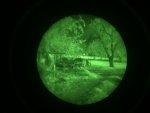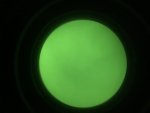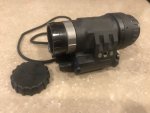BLUF: If I were starting over today and knowing what I know now, if I could afford it, I would start with white phosphor duals.
Now the much, much longer version, hahaha. Lots of good points brought up in this thread so far that I’m going to try to address, starting, obviously, with the original question, but also moving into some of the other points that have been brought up in the discussion.
One of the unfortunate things about NV is that a lot of times it’s simply hard to know what will work best of you until you try it. For example, some people simply cannot use a monocular. It’s a small proportion, but they are out there, their brains simply cannot reconcile the single-NV aided eye and single unaided eye, and actually prefer biocular devices like the PVS-7 to monoculars like the PVS-14.
On the opposite end of that spectrum, very few people I have met, especially when it comes to professional end-users—i.e., people who are using issued devices and therefore would neither care to justify an expensive purchase, nor try to convince themselves that they like something cheaper better profess to prefer a monocular after using dual tubes.
That being said, they are out there.
Unfortunately, the only real way to find out where you might fall here is to try multiple different devices before purchasing, but this is understandably not always a realistic option for many people. However, the “average” user will be able to do fine with a monocular, but will prefer a binocular if it is an option.
Now, beyond individual differences and preferences:
How effective is a monocular alone? A monocular can be very effective when used by a trained user. As others have alluded to, most people have a fairly strong eye dominance, meaning that even in your day to day life in daylight conditions, your brain is primarily processing input from your dominant eye. Your non-dominant eye is primarily providing depth perception (viewing everything from a slightly different angle), supplementary data, and peripheral vision. Granted, most people can change back and forth fairly easily if the dominant eye is no longer receiving good information, whether through injury, sweat, blood, or... because the non-dominant eye has an NVD in front of it, and it’s freaking dark out.
With a monocular, under most lighting conditions, your unaided eye can still provide much of the same supplementary information you’re used to getting from your non-dominant eye, whether you consciously realize it or not. For this reason, a monocular will provide most people with much better depth perception and situational awareness than a biocular device, which uses a single tube to project the same image to both eyes, effectively “tricking” the brain into thinking that it has stereoscopic vision, despite the fact that it is not getting all the supplemental information it thinks it is.
Meanwhile, it is somewhat obvious why so many people prefer duals if they are an option—it allows you to use your eyes the way you’re used to using them, namely, both of them, looking at slightly different things, allowing you to create a stereoscopic image.
A note on wearing dual tubes:
A lot of people will claim that a monocular will give you better situational awareness of lighting changes, along with better peripheral vision because they are able to use their unaided eye. This can be true to a certain extent, however, the reality is that often, whether wearing a monocular or binocular NVD, most users simply wear them too close and too low to their faces, to the point where their entire FOV is consumed by the device. Rubber eye-cups make this even worse, as they close off your eye(s) from any external inputs.
A much better option is to both a) either to remove or at least roll back the rubber eye cups, and b) wear the NVD (mono or bino) further forward and higher up, so that the NV image sits in the upper 2/3rds of the “natural” field of view, while leaving the lower 1/3rd or so of your FOV unobscured, rather like wearing bifocals. This also gives you a “full” FOV “beyond” the 40 degree FOV offered by the device alone.
This allows you to “look” up (or slightly tilt your head down), and still have a full NV view, but you can also tip your head up, and look under the NVD if you’re suddenly in a lit environment and don’t have time to stow your NVDs. This also allows you to continue to receive supplementary information about lighting conditions and peripheral vision, even while wearing dual-tube goggles, and while it is true that binoculars eliminate the possibility of keeping one eye dark-adapted, the reality is that under most conditions that a dark-adapted eye is needed—an NV-aided image will be more useful, most other scenrios involve stronger artificial light situations, whether they are street lights/room lights, or weapon-mounted white lights, where the “advantage” of having a dark-adapted eye is largely moot.
A lot of folks have brought up how much better duals are for driving, or god forbid, flying—but this is only part of the story: the reality is that duals give you better information about your environment, surroundings, and relative distances, the difference is that when you’re moving very fast, i.e., driving or flying, it makes a big difference, it’s just that when you’re walking, you’re moving slowly enough to be able to manage sub-optimal visual data, nevertheless, the things that make dual tubes far superior while moving extremely fast don’t go away when you’re moving slowly, they’re just a little less important.
Taking a detour—using both a thermal monocular and an NV monocular at the same time head mounted is not necessarily impossible, but extremely difficult for most people, because the images and information are not only so different, but depending on the type of thermal device, you may have a lag due to refresh rates of the thermal image that you may not consciously notice, but your brain most certainly will. This of course does not apply to fusion systems like the PAS-29 and other COTI devices or devices like the AN/PSQ-20 ENVG and PSQ-36 FGS.
Others have covered white phosphor versus green phosphor fairly well, so I would only have a couple of things to add:
The main benefit of currently available WP tubes versus green phosphor tubes is mostly a function of the extremely high-specs of the L3 WP Unfilmed tubes, not the phosphor color itself. [Shameless plug] The unfilmed white phosphor tubes we carry in our devices come direct from L3 and must meet out custom spec requirements, and while the very highest spec’ed tubes are being reserved for those at the very tip top of the spear, our custom specs are comparable to the tubes to those being delivered to for military use.
At the same time, as others have mentioned—just because a tube is white phosphor does not necessarily mean that it’s an L3 unfilmed tube, there are filmed white phosphor tubes, as well as Gen. 2+ white phosphor tubes, and these tubes can run the full spectrum of quality, but white phosphor itself is not an indicator of quality or performance, it’s the other specifications that you need to look at to ensure that you get a good tube.
Now, in terms of which is “better” in an equal spec’ed green or white tube:
Most users report that they find white phosphor preferable, that it creates less eye strain, particularly during sustained use, provides a better image, and gives them more contrast and detail. This opinion is strong enough that US SOF is almost completely making the shift to WP tubes.
That being said, every individual is different, and almost certainly, someone will again point out that the human eye is supposed to be able to perceive more shades of green than any other color (hence the reason for green phosphor being selected in the first place), and that the WP image being brighter is simply a matter of perception, but is not actually true.
Ultimately, this all may be scientifically correct, however, none of it changes the fact that again, with a small minority of exceptions, professional end users who are not constrained by budget concerns tend to prefer WP over green for their purposes. Again, the reality is that while the scientific body of knowledge is extremely useful, we still don’t necessarily understand fully how the brain receives and interprets the information being received from the eyes and how that translates to operational performance.
So, some thoughts about employment, starting with dominant versus non-dominant eye for a monocular:
The conventional wisdom has long been to prefer the use of the non-dominant eye with a monocular like the PVS-14. This is the way I was taught as I was “coming up,” and has been taught a long time by some very experienced guys.
This technique was often driven by a rationale that your dominant eye would be “better” at receiving information without NV-aid, while your non-dominant eye would get the better information, “evening things out.”
However, as I explained above, that’s simply not really how most people’s eyes work, and in fact, the “confusion” of receiving the “better” image through the non-dominant eye can cause some people bad enough headaches to make non-dominant eye use almost impossible.
On the other hand, with the increasing proliferation of dual tube goggles, end-users have begun to realize that even when using only a single tube, having your dominant eye be able to see well is really, really useful. In fact, your brain doesn’t really care how well your non-dominant and/or un-aided eye can see as long as it’s getting its supplemental information—however, your brain is used to using your dominant eye to get most of its information, and is therefore simply generally better at interpreting information from that eye.
This, and a few other reasons I will also go into have led to many people beginning to change from recommending the use of monoculars over the non-dominant eye to the dominant, or at very least, “whatever you’re most comfortable with,” i.e., don’t try to fight yourself to use your non-dominant eye if you’re more comfortable with your dominant.
Another reason also relates to the final point I will touch on, aiming:
In the past, the conventional wisdom about aiming while using NVDs has been “IR Laser or nuttin’!”
However, while IR lasers are still extremely effective and extremely useful, it has become increasingly obvious that the US and its allies are not the only ones with NV technology—NV devices can be bought on Amazon, units have been lost or stolen overseas, and in many cases we have fielded large numbers of devices to host nation forces that can and do fall into enemy hands with disturbing regularity.
Moreover—it doesn’t take a top of the line Gen. 3 device to be able to detect a force trying to sneak around in the dark if they’re flashing their IR lasers all over the place and lighting up their movement like a Christmas Tree, under the mistaken assumption that they can’t be seen.
Because of this, there has been an increased interest and emphasis on using passive aiming techniques when the situation may dictate, that is using a head mounted NVD to sight directly through an NV-compatible weapon sight.
Of course, depending on the height of your weapon sights, you can run into some significant hardware interference if you’re trying to run “traditional height” optics/optic mounts, and a “nose to charging handle” (with ARs) shooting technique. This has then contributed to the increasing popularity of “tall” optics, as well as the use of risers under traditional height optics to make it easier to aim passively through the sight with an NVD. Obviously, there are other advantages to high mounted optics, but interoperability with head-mounted NVDs has been one of the main advantages of these mounts, with companies like Geissele, KAC, ADM, and others now offering mounts ranging between 1.93” to 2.33” above the top of an AR reciever rail (for comparison, most absolute cowitness optics are ~1.52-1.54” tall).
Now, another one of the reasons often cited for using an NV monocular over the non-dominant eye has been that been that the day sight could still be used, either as an occluded eye sight, or in a transition to white light. While this will work, IMHO, it is far from an ideal situation compared to using the monocular to aim through the primary sight while on an NV-setting.
Meanwhile, during transitions to white light, with the NVD mounted “forward and high,” and with the optic on a taller mount, the user can engage with the primary optic from under the NVD. Moreover, many users seem to continue to think the NVD’s can’t be used in visible lighting conditions. However, it’s not that they won’t function, it’s simply not good for the device, however, you can still engage through an NVD with white light, either using the IR laser or primary optic if need be. Again, positioning the NVD high and forward allows you to have a full FOV “when the lights go on,” but you will still be able to see IR lasers through it—the housing will largely “disappear,” much like the housing of an RDS disappears when shooting with the both eyes open. Both these techniques will work with either a monocular or binocular NVD.
Whew. A little longer than I intended, hahaha...
~Augee







